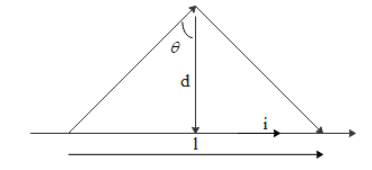Answer
405.3k+ views
Hint: Apply Biot Savart's law. Let us consider two magnetic fields ${{B}_{1}}\And {{B}_{2}}$.Given that the point P is at a distance d from the wire. Hence, here calculate the value of ${{B}_{1}}$. The value of ${{B}_{1}}$ is the product of permeability of free space and the current flowing through the wire to the product of two pi and the distance. Then calculate the magnetic field at ${{B}_{2}}$. Here also consider the same equation as the above. But here consider the sine of the angle also. Then by equating both ${{B}_{1}}\And {{B}_{2}}$we will get the value of $d/l$.
Complete answer:

The magnetic field,
${{B}_{1}}=\dfrac{{{\mu }_{0}}I}{2\pi d}$
The magnetic field,
${{B}_{2}}=\dfrac{{{\mu }_{0}}I}{4\pi d}\left( \sin \theta +\sin \theta \right)$
$\Rightarrow {{B}_{2}}=\dfrac{{{\mu }_{0}}I}{4\pi d}\times 2\sin \theta $
$\Rightarrow {{B}_{2}}=\dfrac{{{\mu }_{0}}I}{4\pi d}\times 2\times \dfrac{l}{2\sqrt{{{d}^{2}}+{{\left( \dfrac{l}{2} \right)}^{2}}}}$
$\begin{align}
& \dfrac{{{B}_{1}}-{{B}_{2}}}{{{B}_{1}}}=0.01 \\
& \Rightarrow 1-\dfrac{{{B}_{2}}}{{{B}_{1}}}=0.01 \\
& \Rightarrow \dfrac{{{B}_{2}}}{{{B}_{1}}}=1-0.01 \\
& \Rightarrow \dfrac{{{B}_{2}}}{{{B}_{1}}}=0.99 \\
& \\
\end{align}$
${{B}_{2}}={{B}_{1}}\times \dfrac{l}{2\sqrt{{{d}^{2}}+{{\left( \dfrac{l}{2} \right)}^{2}}}}$
$\Rightarrow 0.99=\dfrac{l}{2\sqrt{{{d}^{2}}+{{\left( \dfrac{l}{2} \right)}^{2}}}}$
$\Rightarrow {{0.99}^{2}}=\dfrac{{{l}^{2}}}{4\left( {{d}^{2}}+\dfrac{{{l}^{2}}}{4} \right)}$
$\Rightarrow {{0.99}^{2}}\times 4\times \left( {{d}^{2}}+\dfrac{{{l}^{2}}}{4} \right)={{l}^{2}}$
$\Rightarrow {{0.99}^{2}}\times \left( {{d}^{2}}+\dfrac{{{l}^{2}}}{4} \right)=\dfrac{{{l}^{2}}}{4}$
$\Rightarrow {{0.99}^{2}}{{d}^{2}}=\dfrac{{{l}^{2}}}{4}\left( 1-{{0.99}^{2}} \right)$
$\Rightarrow {{0.99}^{2}}{{d}^{2}}=\dfrac{{{l}^{2}}}{4}\times 0.0199$
$\Rightarrow 197.005{{d}^{2}}={{l}^{2}}$
Rearranging the equation and taking the square root we get,
$\begin{align}
& \Rightarrow \dfrac{{{d}^{2}}}{{{l}^{2}}}=\dfrac{1}{197.005} \\
& \therefore \dfrac{d}{l}=0.0712 \\
\end{align}$
Additional information:
The magnetic phenomena are universal in nature. The earth behaves as a magnetic field pointing in geographic south to north. When a bar magnet is suspended freely, it shows its pole in the north- south direction. The tip which points to geographic north is called north pole and tip which points to the geographic south is called the south pole of the magnet. There will be a repulsive force when north poles of two magnets are brought close together. We cannot isolate the north, or south poles of a magnet. That is, if we broke a bar magnet into two halves, we get two bar magnets of similar but weak properties.
Note:
Here Biot Savart’s law is employed. This law is used in case of constant electric current, that produces or generates a constant magnetic field. It also describes the direction , magnitude etc. of the magnetic field. It is also used to calculate the magnetic field intensity. Biot savart’s law thus relates magnetic fields with the current.
Complete answer:

The magnetic field,
${{B}_{1}}=\dfrac{{{\mu }_{0}}I}{2\pi d}$
The magnetic field,
${{B}_{2}}=\dfrac{{{\mu }_{0}}I}{4\pi d}\left( \sin \theta +\sin \theta \right)$
$\Rightarrow {{B}_{2}}=\dfrac{{{\mu }_{0}}I}{4\pi d}\times 2\sin \theta $
$\Rightarrow {{B}_{2}}=\dfrac{{{\mu }_{0}}I}{4\pi d}\times 2\times \dfrac{l}{2\sqrt{{{d}^{2}}+{{\left( \dfrac{l}{2} \right)}^{2}}}}$
$\begin{align}
& \dfrac{{{B}_{1}}-{{B}_{2}}}{{{B}_{1}}}=0.01 \\
& \Rightarrow 1-\dfrac{{{B}_{2}}}{{{B}_{1}}}=0.01 \\
& \Rightarrow \dfrac{{{B}_{2}}}{{{B}_{1}}}=1-0.01 \\
& \Rightarrow \dfrac{{{B}_{2}}}{{{B}_{1}}}=0.99 \\
& \\
\end{align}$
${{B}_{2}}={{B}_{1}}\times \dfrac{l}{2\sqrt{{{d}^{2}}+{{\left( \dfrac{l}{2} \right)}^{2}}}}$
$\Rightarrow 0.99=\dfrac{l}{2\sqrt{{{d}^{2}}+{{\left( \dfrac{l}{2} \right)}^{2}}}}$
$\Rightarrow {{0.99}^{2}}=\dfrac{{{l}^{2}}}{4\left( {{d}^{2}}+\dfrac{{{l}^{2}}}{4} \right)}$
$\Rightarrow {{0.99}^{2}}\times 4\times \left( {{d}^{2}}+\dfrac{{{l}^{2}}}{4} \right)={{l}^{2}}$
$\Rightarrow {{0.99}^{2}}\times \left( {{d}^{2}}+\dfrac{{{l}^{2}}}{4} \right)=\dfrac{{{l}^{2}}}{4}$
$\Rightarrow {{0.99}^{2}}{{d}^{2}}=\dfrac{{{l}^{2}}}{4}\left( 1-{{0.99}^{2}} \right)$
$\Rightarrow {{0.99}^{2}}{{d}^{2}}=\dfrac{{{l}^{2}}}{4}\times 0.0199$
$\Rightarrow 197.005{{d}^{2}}={{l}^{2}}$
Rearranging the equation and taking the square root we get,
$\begin{align}
& \Rightarrow \dfrac{{{d}^{2}}}{{{l}^{2}}}=\dfrac{1}{197.005} \\
& \therefore \dfrac{d}{l}=0.0712 \\
\end{align}$
Additional information:
The magnetic phenomena are universal in nature. The earth behaves as a magnetic field pointing in geographic south to north. When a bar magnet is suspended freely, it shows its pole in the north- south direction. The tip which points to geographic north is called north pole and tip which points to the geographic south is called the south pole of the magnet. There will be a repulsive force when north poles of two magnets are brought close together. We cannot isolate the north, or south poles of a magnet. That is, if we broke a bar magnet into two halves, we get two bar magnets of similar but weak properties.
Note:
Here Biot Savart’s law is employed. This law is used in case of constant electric current, that produces or generates a constant magnetic field. It also describes the direction , magnitude etc. of the magnetic field. It is also used to calculate the magnetic field intensity. Biot savart’s law thus relates magnetic fields with the current.
Recently Updated Pages
How many sigma and pi bonds are present in HCequiv class 11 chemistry CBSE

Why Are Noble Gases NonReactive class 11 chemistry CBSE

Let X and Y be the sets of all positive divisors of class 11 maths CBSE

Let x and y be 2 real numbers which satisfy the equations class 11 maths CBSE

Let x 4log 2sqrt 9k 1 + 7 and y dfrac132log 2sqrt5 class 11 maths CBSE

Let x22ax+b20 and x22bx+a20 be two equations Then the class 11 maths CBSE

Trending doubts
Fill the blanks with the suitable prepositions 1 The class 9 english CBSE

At which age domestication of animals started A Neolithic class 11 social science CBSE

Which are the Top 10 Largest Countries of the World?

Give 10 examples for herbs , shrubs , climbers , creepers

Difference between Prokaryotic cell and Eukaryotic class 11 biology CBSE

Difference Between Plant Cell and Animal Cell

Write a letter to the principal requesting him to grant class 10 english CBSE

Change the following sentences into negative and interrogative class 10 english CBSE

Fill in the blanks A 1 lakh ten thousand B 1 million class 9 maths CBSE



